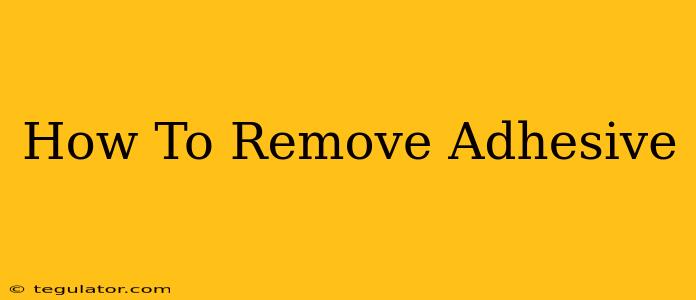Sticky situations got you down? Whether it's stubborn glue residue from a DIY project gone wrong, the lingering remnants of a sticker, or that pesky price tag that just won't budge, removing adhesive can be a frustrating experience. But fear not! This comprehensive guide will walk you through various methods to tackle those sticky situations, ensuring you get a clean, adhesive-free surface every time.
Understanding Different Types of Adhesives
Before diving into removal techniques, it's crucial to understand the type of adhesive you're dealing with. Different adhesives require different approaches. Here are some common types:
- Water-based adhesives: These are generally the easiest to remove and often respond well to simple cleaning methods. Think of glues used for paper or some craft projects.
- Solvent-based adhesives: These are stronger and require more aggressive removal methods. Many super glues and construction adhesives fall into this category.
- Hot melt adhesives: These are thermoplastic adhesives that soften with heat. Glue guns often use this type of adhesive.
- Pressure-sensitive adhesives: These are found in stickers, tape, and many labels. They adhere through pressure and can be tricky to remove completely.
Effective Methods for Adhesive Removal
Now let's explore various techniques to effectively remove different types of adhesives. Remember to always test your chosen method on an inconspicuous area first to prevent damage to the surface.
1. The Power of Heat
Heat can soften many adhesives, making them easier to remove. Here are some heat-based removal options:
- Hair dryer: For less stubborn adhesives, a hair dryer on a low setting can work wonders. Gently heat the adhesive until it softens, then carefully peel it away.
- Heat gun: For more stubborn adhesives, a heat gun (use caution!) can provide more intense heat. Always maintain a safe distance and work in a well-ventilated area.
- Boiling water: For plastic surfaces, carefully pouring boiling water over the adhesive can help soften it for easier removal.
2. The Solvent Solution
Solvents can dissolve many types of adhesives. Here are some common and effective solvents:
- Isopropyl alcohol (rubbing alcohol): This is a gentle yet effective solvent for many water-based and some solvent-based adhesives. Apply it with a cotton ball or cloth, and gently rub.
- Acetone (nail polish remover): A stronger solvent, acetone is effective for removing tougher adhesives, but it can also damage certain surfaces. Test it in an inconspicuous area first!
- White vinegar: A mild acid, white vinegar can be effective for removing some types of glue.
3. Mechanical Removal
Sometimes, a little elbow grease is all you need.
- Plastic scraper: Gently scrape away softened adhesive with a plastic scraper. Avoid metal scrapers as they can scratch the surface.
- Putty knife: For more stubborn adhesive, a putty knife can be helpful, but use it carefully to avoid damaging the underlying surface.
- Baking soda paste: Create a paste of baking soda and water, apply it to the adhesive, let it sit for a while, and then gently scrub. This is particularly helpful for removing sticky residue.
4. Commercial Adhesive Removers
If all else fails, consider using a commercial adhesive remover. These are specifically formulated to dissolve various types of adhesives and are readily available at most hardware stores. Always follow the manufacturer's instructions carefully.
Tips for Success
- Patience is key: Removing adhesive often requires patience and persistence. Don't rush the process.
- Protect the surface: Always protect the surrounding area with masking tape or a cloth to prevent accidental damage.
- Proper ventilation: When using solvents, ensure adequate ventilation to prevent inhaling harmful fumes.
- Clean thoroughly: After removing the adhesive, clean the area thoroughly with soap and water to remove any residue.
By following these tips and techniques, you'll be well-equipped to tackle any sticky situation with confidence and achieve a clean, adhesive-free surface. Remember to always prioritize safety and choose the appropriate method for your specific adhesive and surface type. Happy cleaning!

